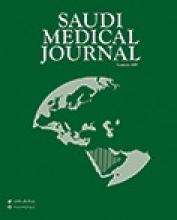Abstract
OBJECTIVE: To describe the clinicopathological features of patients admitted to adult wards with a primary presenting feature of lymphadenopathy.
METHODS: A retrospective study of all patients admitted to Riyadh Medical Complex, Riyadh, Kingdom of Saudi Arabia between April 1996 through to March 2000.
RESULTS: The patients mean age was 35.2 years (standard deviation 15.7 years) and 59.5% were females while 56.2% were Saudis. Swelling was the primary presenting symptom in 39.3% of the patients, while fever, night sweats, and pain occurred in 17.3%, 10.3% and 8.5% patients. There was considerable overlap between benign and malignant causes of lymphadenopathy but in 56.6% of patients, lymphadenopathy was the only sign. The cervical group of lymph nodes was the most commonly affected site. Hepatomegaly, splenomegaly and both organ enlargement occurred in 59 (22.9%) patients. The presence of generalized lymphadenopathy and other physical signs (serositis and organomegaly) highly suggested a malignant process. Granulomatous lymphadenopathy due to tuberculosis was the most frequent pattern 98 (37.9%) followed by lymphoma 85 (32.9%). Tuberculosis was also more common in females than males (51% versus 19%). Among patients with Hodgkin's disease, nodular sclerosis was the most frequent (75%). Routine investigations did not discriminate between benign and malignant causes of lymphadenopathy. The overall mortality rate was 8.1%: with metastatic disease accounting for 52.4%.
CONCLUSION: There were significant similarities and differences between these findings and other previous studies in the Kingdom of Saudi Arabia and elsewhere.
- Copyright: © Saudi Medical Journal
This is an open-access article distributed under the terms of the Creative Commons Attribution-Noncommercial-Share Alike 3.0 Unported, which permits unrestricted use, distribution, and reproduction in any medium, provided the original work is properly cited.






